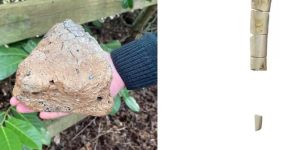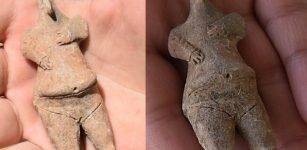Surprising Discovery Of Rare Turtle Statue Under Bayon Temple In Angkor, Cambodia
Jan Bartek - AncientPages.com - Archaeologists thought there was nothing left to find at the Bayon Temple in Angor Archaeological Park in Siem Reap, but they were wrong. "Something" was still down there. At a depth of 1.5 m, a project team from the APSARA National Authority (ANA) unearthed a rare sandstone sculpture of a turtle!
Bayon, Angkor Thom, Cambodia. Credit: Diego Delso - CC BY-SA 3.0
Turtles held a revered status among numerous ancient civilizations. Myths and legends originating from diverse regions of the globe unveil the profound fascination these ancient societies harbored for turtles, elevating the animal to a sacred pedestal across various parts of the world. The turtle, renowned for its remarkable longevity as one of the longest-living creatures on Earth, was frequently associated with the creation of the world itself, symbolizing the profound reverence bestowed upon this remarkable species.
The Bayon temple, a renowned architectural marvel within the Angkor Archaeological Park, is famous for its intricate carvings and colossal stone faces. The recent unearthing of a precious sculpture, measuring 57cm in length, 43cm across, and 21cm in depth, highlights that this ancient site continues to unveil historical secrets. This significant discovery underscores the Bayon temple's enduring cultural and archaeological significance, offering insights into the craftsmanship and artistic traditions of the Khmer Empire.
A rare sandstone turtle sculpture has been unearthed beneath the earth of a former pond at Siem Reap province’s Bayon Temple. Credit: Heritage Protection Police
"While many believed there was nothing left to find, our archaeological research has uncovered evidence that Bayon Temple actually boasted two ponds on its eastern side.
This necessitates a reassessment of the historical significance of these sites," Long Kosal, ANA spokesperson, told The Phnom Penh Post.
The recent excavation at the temple site has yielded significant findings that challenge previous assumptions about the temple's structure. This discovery not only sheds new light on the construction process but also enriches the historical narrative surrounding the temple's origins during King Jayavarman VII's reign in the 12th century.
According to experts, this restoration project holds immense value, surpassing even the importance of discovering a turtle sculpture. The excavation findings will enable a more accurate representation of this remarkable 12th-century construction, which was undertaken under the visionary leadership of Jayavarman VII, to be reintroduced in the 21st century.
The Archaeological Survey Authority of Cambodia (ANA), dedicated to preserving and studying the nation's ancient heritage, views the recent discovery as a valuable opportunity to enhance our understanding of the region's historical architecture and dispel misconceptions about lost underground structures. Kosal, a representative from the ANA, emphasizes that this find, coupled with the recent unearthing of an ancient temple foundation adjacent to the Lolei Temple within Angkor Park, underscores the dynamic history embedded within Cambodia's landscape.
Notably, the Lolei Temple, the northernmost structure among the Roluos group of three late 9th-century Hindu temples, faces structural challenges due to a contemporary pagoda being constructed nearby. This situation highlights the delicate balance between preserving ancient heritage and accommodating modern developments.
Credit: Heritage Protection Police
The pagoda's construction raised concerns about potential strain on the temple's foundations. To address this issue and preserve Cambodia's historical heritage, a collaborative approach was taken involving monks, residents, and authorities. This led to the decision to modify certain structures on the hill. Subsequently, a team from the ANA (Authority for the Protection and Management of Angkor and the Region of Siem Reap) excavated the relatively shallow hill, uncovering numerous ancient temple structures.
See also: More Archaeology News
According to Kosal, these latest discoveries at Bayon and Lolei temples not only provide new insights into the architectural achievements of the ancient Khmer civilization but also highlight the importance of collaborative archaeological practices. As each layer of soil is removed, the history of the Khmer Empire is gradually pieced together, offering a clearer understanding of this proud civilization's legacy.
Written by Jan Bartek - AncientPages.com Staff Writer























